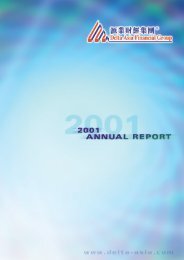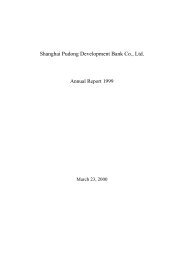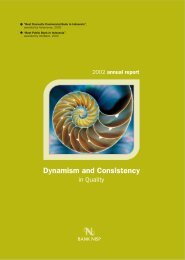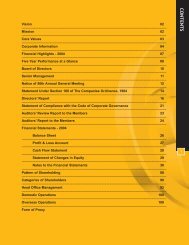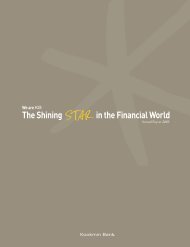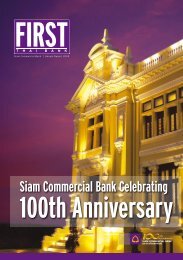Banco de Oro Universal Bank provides a - Asianbanks.net
Banco de Oro Universal Bank provides a - Asianbanks.net
Banco de Oro Universal Bank provides a - Asianbanks.net
- No tags were found...
You also want an ePaper? Increase the reach of your titles
YUMPU automatically turns print PDFs into web optimized ePapers that Google loves.
2005 ANNUAL REPORT39• Available-for-sale Financial Assets. This inclu<strong>de</strong>s non-<strong>de</strong>rivative financial assets that are either <strong>de</strong>signated to this category or do notqualify for inclusion in any of the other categories of financial assets.All financial assets within this category are subsequently measured at fair value, unless otherwise disclosed, with changes in valuerecognized in capital funds, <strong>net</strong> of any effects arising from income taxes. Gains and losses arising from securities classified asavailable-for-sale are recognized in the statements of income when they are sold or when the investment is impaired.In the case of impairment, any loss previously recognized in capital funds is transferred to the statements of income (see Note 3.18).Losses recognized in the statements of income on equity investments are not reversed through the statements of income. Lossesrecognized in prior period statements of income resulting from the impairment of <strong>de</strong>bt instruments are reversed through thestatements of income, when there is recovery in the amount of previously recognized impairment losses.The fair values of quoted investments in active markets are based on current bid prices. If the market for a financial asset is not active (andfor unlisted securities), the Group establishes fair value by using valuation techniques, which inclu<strong>de</strong> the use of recent arm’s lengthtransactions, discounted cash flow analysis, option pricing mo<strong>de</strong>ls and other valuation techniques commonly used by market participants.Gains and losses arising from changes in the fair value of the financial assets at fair value through profit or loss category are inclu<strong>de</strong>d in Tradingand Securities Gain – <strong>net</strong> account in the statements of income in the period in which they arise. Gains and losses arising from changes in thefair value of available-for-sale financial assets are recognized directly in capital funds, until the financial asset is <strong>de</strong>recognized or impaired atwhich time the cumulative gain or loss previously recognized in capital funds shall be recognized in profit or loss. However, interest calculatedusing the effective interest method is recognized in the statements of income. Divi<strong>de</strong>nds on available-for-sale equity instruments arerecognized in the statement of income when the entity’s right to receive payment is established.Non-compounding interest and other cash flows resulting from holding financial assets are recognized in profit or loss when received,regardless of how the related carrying amount of financial assets is measured.Derecognition of financial assets occurs when the rights to receive cash flows from the financial instruments expire or are transferred andsubstantially all of the risks and rewards of ownership have been transferred.3.7 Derivative Financial Instruments and Hedge AccountingThe Group is a party to various foreign currency forward and swap contracts and cross-currency and interest rate swaps. These contracts areentered into as a service to customers and as a means of reducing or managing the Group’s foreign exchange and interest rate exposures aswell as for trading purposes.Derivatives are initially recognized at fair value on the date on which <strong>de</strong>rivative contract is entered into and are subsequently measured attheir fair value. Fair values are obtained from quoted market prices in active markets, including recent market transactions, and valuationtechniques, including discounted cash flow mo<strong>de</strong>ls and option pricing mo<strong>de</strong>ls, as appropriate. All <strong>de</strong>rivatives are carried as assets when fairvalue is positive and as liabilities when fair value is negative.The best evi<strong>de</strong>nce of the fair value of a <strong>de</strong>rivative at initial recognition is the transaction price (the fair value of the consi<strong>de</strong>ration given orreceived) unless the fair value of that instrument is evi<strong>de</strong>nced by comparison with other observable current market transactions in the sameinstrument or based on a valuation technique whose variables inclu<strong>de</strong> only data from observable markets. When such evi<strong>de</strong>nce exists, theGroup recognizes profits at initial recognition.Certain <strong>de</strong>rivatives embed<strong>de</strong>d in other financial instruments, such as the conversion option in a convertible bond and credit <strong>de</strong>fault swap in acredit linked note, are consi<strong>de</strong>red as separate <strong>de</strong>rivatives when their economic characteristics and risks are not closely related to those of thehost contract and the host contract is not carried at fair value through profit or loss. These embed<strong>de</strong>d <strong>de</strong>rivatives are measured at fair valuewith changes in fair value recognized in the statements of income.Except for <strong>de</strong>rivatives that qualify as a hedging instrument, change in the fair value of <strong>de</strong>rivatives are recognized in profit or loss. The methodof recognizing the resulting fair value gain or loss on <strong>de</strong>rivatives that qualify as hedging instrument <strong>de</strong>pends on the hedging relationship<strong>de</strong>signated by the Group. The Group <strong>de</strong>signates certain <strong>de</strong>rivatives as either: (1) hedges of the fair value of recognized assets or liabilities orfirm commitments (fair value hedge); or (2) hedges of highly probable future cash flows attributable to a recognized asset or liability, or aforecasted transaction (cash flow hedge). Hedge accounting is used for <strong>de</strong>rivatives <strong>de</strong>signated in this way provi<strong>de</strong>d certain criteria are met.The Group documents, at the inception of the transaction, the relationship between hedging instruments and hedged items, as well as its riskmanagement objective and strategy for un<strong>de</strong>rtaking various hedge transactions. The Group also documents its assessment, both at hedgeinception and on an ongoing basis, of whether the <strong>de</strong>rivatives that are used in hedging transactions are highly effective in offsetting changesin fair values or cash flows of hedged items.• Fair value hedge. Changes in the fair value of <strong>de</strong>rivatives that are <strong>de</strong>signated and qualify as fair value hedges are recor<strong>de</strong>d in thestatements of income, together with any changes in the fair value of the hedged asset or liability that are attributable to the hedgedrisk.If the hedge no longer meets the criteria for hedge accounting, the adjustment to the carrying amount of a hedged item for whichthe effective interest method is used is amortized to profit or loss over the period to maturity. The adjustment to the carryingamount of a hedged equity security remains as part of capital funds until the disposal of the equity security.• Cash flow hedge. The effective portion of changes in the fair value of <strong>de</strong>rivatives that are <strong>de</strong>signated and qualify as cash flowhedges are recognized in capital funds. The gain or loss relating to the ineffective portion is recognized immediately in thestatements of income.



